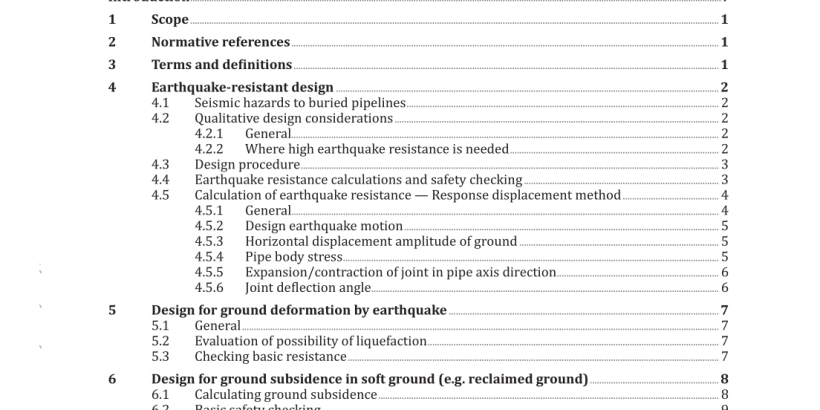BS ISO 16134:2020 pdf download – Earthquake-resistant and subsidence-resistant design of ductile iron pipelines.
1 Scope This document specifies the design of earthquake-resistant and subsidence-resistant ductile iron pipelines suitable for use in areas where seismic activity and land subsidence can be expected. It provides a means of determining and checking the resistance of buried pipelines and gives example calculations. It is applicable to ductile iron pipes and fittings with joints as specified in ISO 2531, ISO 7186 and ISO 16631 that have expansion/contraction and deflection capabilities, used in pipelines buried underground. NOTE Subsidence is not the effects of an earthquake or a sinkhole. 2 Normative references The following documents are referred to in the text in such a way that some or all of their content constitutes requirements of this document. For dated references, only the edition cited applies. For undated references, the latest edition of the referenced document (including any amendments) applies. ISO 2531, Ductile iron pipes, fittings, accessories and their joints for water applications 3? Terms? and? definitions For the purposes of this document, the terms and definitions given in ISO 2531 and the following apply. ISO and IEC maintain terminological databases for use in standardization at the following addresses: — ISO Online browsing platform: available at https:// www .iso .org/ obp — IEC Electropedia: available at http:// www .electropedia .org/
4 Earthquake-resistant design 4.1 Seismic hazards to buried pipelines In general, there are several main causes of seismic hazards to buried pipelines: a) ground displacement and ground strain caused by seismic ground shaking; b) ground deformation such as a ground surface crack, ground subsidence and lateral spread induced by liquefaction; c) relative displacement at the connecting part with the structure, etc.; d) ground displacement and rupture along a fault zone. Since the ductile iron pipe has high tensile strength as well as the capacity for expansion/contraction and deflection from its joint part, giving it the ability to follow the ground movement during the earthquake, the stress generated on the pipe body is relatively small. Few ruptures of pipe body have occurred during earthquakes in the past. It is therefore important to consider whether the pipeline can follow the ground displacement and ground strain without slipping out of joint when considering its earthquake resistance. The internal hydrodynamic surge pressures induced by seismic shaking are normally small enough not to be considered. 4.2 Qualitative design considerations 4.2.1 General To increase the resistance of ductile iron pipelines to seismic hazards, the following qualitative design measures should be taken into consideration. a) Provide pipelines with expansion/contraction and deflection capability. EXAMPLE Use of shorter pipe segments, special joints or sleeves and anti-slip-out mechanisms according to the anticipated intensity or nature of the earthquake. b) Lay pipelines in a firm foundation. c) Use smooth back fill materials. NOTE Polyethylene sleeves and special coating are also effective in special cases. d) Install more valves.
4.4 Earthquake resistance calculations and safety checking When checking the resistance of pipelines to the effects of earthquakes, the calculation shall be carried out for the condition in which the normal load (dead load and normal live load) is combined with the influence of the earthquake. The pipe body stress, expansion/contraction value of joint, and deflection angle of joint are calculated by the response displacement method. Earthquake resistance is checked by comparing these values with their respective allowable values. The basic criteria are given in Table 1. A flowchart of earthquake resistance determination and safety checking is shown in Figure 1. The basic formulae only for earthquake resistance calculation are given in 4.5. A detailed example of calculation is given in Annex A.
4.5.2 Design earthquake motion The design acceleration for different seismic intensity scales can be determined according to the relationship between the several kinds of seismic intensity scales and the acceleration of ground surface, as given in Annex B.
